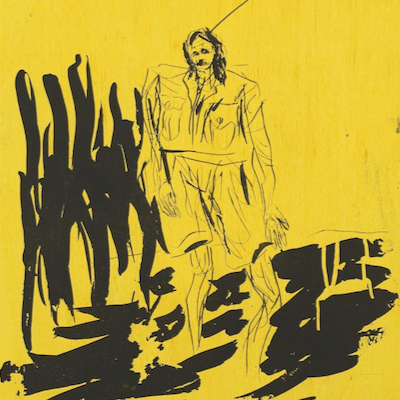
Details
Artist
Styles
Watercolor and pencil on paper. Hand-signed by the artist, bottom. Markus Lüpertz’s Eagle o.T (1999-2000) is a striking watercolor and pencil composition that embodies his expressive, neo-expressionist style. The work features a bold, roughly sketched eagle, its form outlined in energetic strokes of blue and orange, contrasting against the darker washes of gray and black. The loose, gestural lines and overlapping colors lend the piece a raw, dynamic quality, reinforcing Lüpertz’s interest in mythology, symbolism, and the tension between abstraction and representation. As one of Germany’s most prominent post-war artists, Lüpertz is known for his exploration of historical and cultural themes, often using bold, primitive-like forms to evoke emotional and intellectual responses. Here, the eagle—a symbol of power, freedom, and identity—appears almost spectral, caught between strength and fragility. The textured paper and visible brushstrokes further enhance the work’s immediacy, making it a compelling example of Lüpertz’s expressive visual language.
Eagle o.T, 1999-2000
form
Medium
Size
30 x 21 cm
- Inches
- Centimeters
Edition
Price
- USD
- EUR
- GBP
Details
Artist
Styles
Watercolor and pencil on paper. Hand-signed by the artist, bottom. Markus Lüpertz’s Eagle o.T (1999-2000) is a striking watercolor and pencil composition that embodies his expressive, neo-expressionist style. The work features a bold, roughly sketched eagle, its form outlined in energetic strokes of blue and orange, contrasting against the darker washes of gray and black. The loose, gestural lines and overlapping colors lend the piece a raw, dynamic quality, reinforcing Lüpertz’s interest in mythology, symbolism, and the tension between abstraction and representation. As one of Germany’s most prominent post-war artists, Lüpertz is known for his exploration of historical and cultural themes, often using bold, primitive-like forms to evoke emotional and intellectual responses. Here, the eagle—a symbol of power, freedom, and identity—appears almost spectral, caught between strength and fragility. The textured paper and visible brushstrokes further enhance the work’s immediacy, making it a compelling example of Lüpertz’s expressive visual language.
- Recently Added
- Price (low-high )
- Price (high-low )
- Year (low-high )
- Year (high-low )
Who are the Neue Wilden?
Neue Wilden is the term German artists used for Neo-Expressionism. In the 1970s and 80s, expressive painting re-emerged in Germany, with artists embracing intense colors and broad brushstrokes. The movement grew in opposition to minimal and conceptual art, favoring a return to raw, emotional expression through bold and dynamic painting techniques.



















